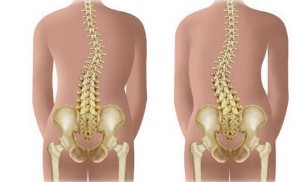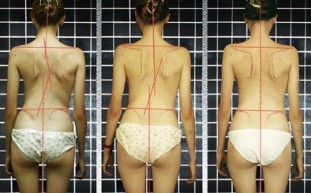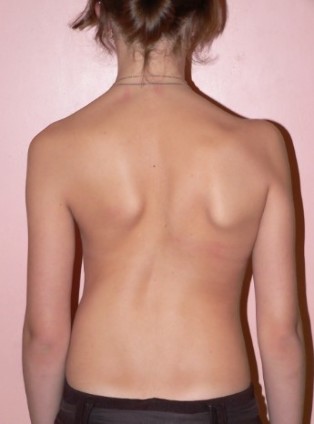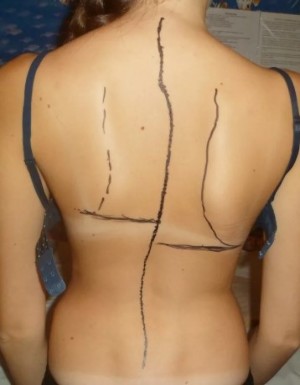In the Greek language, the word "scolios", which translates as "the curve". This word, doctors describe the curvature of the spine. But not every curvature, namely, the lateral displacement of the vertical axis of the spine. The fact that our spine is not in the standard perfectly smooth. Available in the front and rear direction of the lordosis and kyphosis), turn (protects the spine from excessive loads while maintaining the body in a certain Position in the moving and transporting of heavy loads. The negative processes in our body develop only in the cases when this kyphosis and lordosis pronounced over the allowable standard.

The Main Problems
But even a small degree of lateral curves (scoliosis) of the spine is always abnormal. And it's not just cosmetic cause. Although the characteristic repulsive appearance under the Express or advancing scoliosis, it is always tried to be a tragedy for the people, to quality of living a fulfilling life. This is especially true for boys and girls. However, it is precisely in the period of childhood and youth (up to 15 – 16 years old) is diagnosed, a significant part of the scoliosis.
The main problem consists of that due to the change in the configuration and volume of the Breasts with pronounced lateral curvature of the internal organs (heart, lungs, stomach, liver, intestines, major blood vessels) always suffer. In men, the decreases tolerance to physical stress in women, the problems with the conception, bearing pregnancy and childbirth. In addition, very often a lateral deformation of the spine – it is only a part of the surface of the iceberg, a sign of a much more serious pathology – tumors, tuberculosis, endocrine disorders.
Causes
So why deform the spine? Before you answer the question, we define the types of scoliosis. Essentially, scoliosis, structural and non-structural can. Structural scoliosis can develop due to anatomical changes in the structure of the bone tissue of the vertebral body, as well as nearby muscles, nerves, ligaments. Such a curvature can be acquired or congenital, wherein the proportion of the latter is approximately diagnosed a quarter of the scoliosis.
To distinguish the main causes of the structural development of the scoliosis:

- Malformations of the fetal development, the dysplastic violations of one or more vertebrae
- Congenital malformations of the chest – no edges, the additional ribs
- A congenital disorder of the connective tissue, neurofibromatosis, Marfan syndrome
- Cerebral insufficiency as the result of infantile cerebral palsy (ICP), a disorder of the Innervation of certain sections of the spine
- Osteoporosis (bone loss) in the case of rickets, the spine, diseases of the parathyroid glands, chard of Calcium with the food
- Osteomyelitis of the vertebrae
- Degenerative changes of the cervical, thoracic and lumbar muscles
- Tuberculous damage to the spine
- Injuries of the spine
- Tumors of the spine.
Non-structural scoliosis, as the name implies, it is the lateral deviation of the axis of the spine without changing the structure of the vertebral body. In General, such a scoliosis, the compensation is usually acquired with the exception of those cases where the curvature contributes to congenital anatomical defects of the pelvis or the lower extremities. Causes for scoliosis are usually:
- Injuries of the pelvis and lower extremities
- Deformities of the pelvis and lower extremities
- Permanent poor posture in students
- Diseases of the internal organs with asymmetric pain syndrome
- Inflammation of the muscles (Myositis)
- Burns, scars, soft parts with a single page.
In these cases, the cure for the curvature of the spine, in enough, underlying disease, and as many non-structural scoliosis are easily reversible. In this connection, some doctors tend to, not as a non-structural deformation to scoliosis at all.

In recent cases of young people with scoliosis causes, accumulated cleared. This so-called idiopathic scoliosis. It occurs in the teenage years, in the period of rapid growth of the body. And girls suffer in idiopathic scoliosis a couple of times more often than boys. Apparently, this is due to the relatively weak muscles of the back in the female sex, the skeleton will not be able to close the spine into a full-fledged muscle. Not the last role in the development of idiopathic scoliosis plays an unbalanced diet with a low content of calcium, the enthusiasm of the youth of carbonated drinks. It is known that carbon dioxide in the bubbles and phosphoric acid in the composition of the synthetic inclusions contribute to the leaching of the salts of calcium from the body.
Varieties and dimensions Standard
Depending on the localization of the scoliosis, neck strap, a chest of drawers, cash, or mixed (cervical and thoracic, lumbar chest) can. Perhaps the presence of one or more of the arc of curvature. In this respect, the C-shaped scoliosis (1 sheet), S different-shaped (with 2 sheets) and Z-shaped (with 3 bows). Probably, the presence of 2 or 3 arc bears the compensation. The C-shaped scoliosis, the axis of the spine is prevented. In an effort to offset it, the spine bends in the opposite direction. In this context, scoliosis parts on the compensated and uncompensated. In the case of the compensated curvatures of the spine, a vertical line, can be made up of 7 cervical vertebrae, runs through the crease between the buttocks.
Curvature of the spine very often the combined character. For example, in the Department in addition to the lateral curvature of pathological kyphosis, or simply hump to be celebrated. In these cases, talk about the in kyphoscoliosis . At higher degrees of scoliosis, in addition to the lateral displacement of the vertebral torsion celebrated. In the literal translation rotation means. In fact, many of the scoliosis bone tissue of the vertebra wavy on the vertical axis.
Depending on the size of the angle of curvature of the arc 4 degree of scoliosis mark:
- 1 degree – the angle of curvature is not more than 10 degrees. Asymmetry in the eye is practically not detected. Guides to slouch the attention, uneven level of the shoulder girdle.
- 2 degree angle of curvature is from 11 to 25 degrees. This amount of torsion is celebrated vertebrae. Visible asymmetry of the shoulder girdle and the pelvis was observed on the eye. Due to the pathological muscle tension muscular cushion formed in the lumbar region with a concave side and in the chest area, with the convex.
- 3 degree of curvature is from 26 to 50 degrees. Visible deformity of the chest – the return of intercostal spaces on the concave side of the curvature and vypiranie with convex. The weakening of the abdominal muscles, the formation of the inner cusp.
- 4 degree angle of curvature, I is more than 50 degrees. Beauty, pronounced error, and all previous signs. Low impact, even a minor physical effort. In addition to the diseases of the musculoskeletal system, the internal organs suffer.

The angle can vary depending on the Position of the body, the stable and unstable scoliosis mark. In the case of an unstable scoliosis, he is able to is reduced in the back, if which reduces the load on the spine. In the case of the stable curvature of the spine, this value remains unchanged.
Symptoms
Lately, often by orthopedists use the term "disease scoliosis". And to complex the negative changes in the body during the bending of the spine call. In General, scoliosis is the disease develops in childhood and adolescence, during the formation of the musculoskeletal system. At this time, there is a high probability that the scoliosis more.
Apparently, not the last role in the increase of the angle of the curvature of the intervertebral discs play. In the case of a lateral displacement of the disk, the unequal pressure on the part of the vertebral body checks. With the concave side the pressure is greater, with less convex. As a result of this disc even more wear on the part of the scoliosis, the abnormal muscle tension (muscular cushion) and the torsional vortex is created – all this leads to the formation of the disk hernias and to a further increase in the angle of the curvature.

Together with the spine in a scoliosis disease, secondary changes in the rib cage. Is formed the so-called rib-hump, with the convex side of the curvature between the ribs, the intervals expand, and with concave – on the contrary, decrease. At 4 degrees scoliosis chest deformity is so pronounced that the lower ribs on the side of the curvature in contact with the iliac crest.
Because of the marked deformation of the Thorax complete Tour during respiration difficult. At the end of the body in severe scoliosis, the required number of oxygen it receives, the so-called chronic hypoxia in violation of the metabolic processes in the body. The pathology is exacerbated by the fact that the internal volume and the shape of the breast changes cave. Because of this impaired circulation of blood through the blood vessels, lung disease, changes the shape of the heart, develops a chronic heart and respiratory failure.
Similar changes occur in the organs of the abdominal cavity with lumbar and lumbar-thoracic scoliosis. Reduces the motility of the stomach and of the intestine with subsequent enzymatic insufficiency of the digestive glands. All this only exacerbates metabolic disorders. These injuries often lead to late puberty, boys and girls. In addition, due to the lumbar scoliosis secondary taz curved. This creates problems for expectant mothers bearing with pregnancy and childbirth.
Diagnosis
Diagnosis of scoliosis, particularly on a large-scale, in General, no difficulties. For detecting the Deformation of the spine often enough to the usual visual inspection. Remarkably, the apparent curvature of the contours of the spine, asymmetry of the shoulder girdle, the angle of the vanes, the secondary curvature of the pelvis and the shortening of the lower extremity on the side of the curvature.
If at least one of these characters shows an x-ray of the spine. To determine the x-ray image, the configuration, the extent and the localization of the curvature. In the course of the investigation and the x-ray examination can be determined whether scoliosis is compensated and stable. Lately, the spread has received qualitatively new method for the examination of the spine – magnetic resonance imaging (MRI), where on the screen you can a three-dimensional image of the spine. In the case of significant curvature to the work of the internal organs must be examined to make a spirometry, electrocardiography, an ultrasound examination of the heart and the internal organs.
Treatment
The treatment of scoliosis can be performed as conservatively and surgically. Among the conservative methods of medical treatment, Massage, physiotherapy, manual therapy. It is important to note that the final formation of the spine completed to 20 years, and after this age, correction of the curvature is almost not possible. In the case of scoliosis 1-2 degree of efforts to the achievement of the original, normal configuration of the spine. In severe scoliosis 3 – 4 degrees is unachievable, here the main thing – to stabilize the spine and the progression of their scoliosis to prevent.

Drugs (chondroprotectors, vitamins, tonic drugs) in the treatment of scoliosis plays only a minor role. The muscles, strengthen the muscular cushion to eliminate, and even in no small measure Standard of stabilization of the spine with the help of Massage and manual therapy. Good effect give physiotherapy exercises. But here, in the case of inadequate physical loads, the instability of the spine and scoliosis reinforced progresses. Therefore, a series of exercises designed for each patient individually, taking into account the localization and the expression of the curvature. In the case of larger degree of scoliosis, strength exercises, jumps, games, outdoor running is contraindicated.
A very good result, correction of regulation, the optimal posture is the normalization of body posture promotes. To special devices., orthopedic crib in which young patients a lot of their time With the ineffectiveness of conservative measures the progression of the curvature progression-operative treatment for the stabilization of the spine. The surgical correction is not shown in early childhood, their behavior in adolescence, when the formation of the spine is almost complete.






























